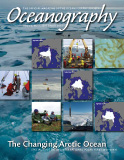Article Abstract
Arctic sea ice cover has declined over the past few decades. The end of summer September ice extent reached a record minimum in 2007. While there has been a modest recovery since then, the past four years (2007–2010) show the lowest sea ice extent in the 30-year satellite record. Submarine and satellite ice thickness measurements show a factor of two decrease (3 m to 1. 4 m) from 1957–1976 to 2003–2007. There has been a shift from sea ice cover consisting mainly of ice more than a year old to ice less than a year old. These changes have resulted in a less robust ice cover that is more sensitive to dynamic and thermodynamic forcing. Changes in atmospheric pressure fields in recent years have affected the distribution of ice in the Arctic Basin. Increases in advected ocean heat through Bering Strait may serve as a trigger for ice retreat in the Chukchi and Beaufort Seas. More open water has led to enhanced solar heat input and warming of the upper ocean and greater ice melt. While there may not be a tipping point for Arctic sea ice cover, positive feedbacks do contribute to rapid changes. The declining Arctic sea ice cover is affecting human activities.

